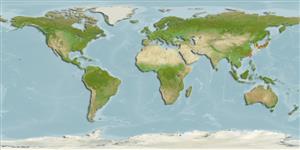Common names from other countries
Environment: milieu / climate zone / depth range / distribution range
Οικολογία
. Tropical; 46°N - 22°N, 113°E - 117°W
Pacific Ocean.
Length at first maturity / Μέγεθος / Βάρος / Age
Maturity: Lm ? range ? - ? cm Max length : 30.0 cm COLD αρσενικό/απροσδιόριστο; (Ref. 2268)
Assumed maximum colony diameter from Ref. 2268. Found in shallow water, including harbours and bays with major boat traffic (Ref. 2268).
Life cycle and mating behavior
Γεννητική Ωρίμανση | Αναπαραγωγή | Γεννοβολία | Αβγά | Γονιμότητα | Προνύμφες
Members of the class Ascidiacea are hermaphroditic; both cross- and self-fertilization is typical. Life cycle: Eggs develop into lecithotrophic larva before metamorphosing into benthic adults.
Bernice Pauahi Bishop Museum. 2000. (Ref. 1601)
IUCN Red List Status (Ref. 130435)
CITES status (Ref. 108899)
Not Evaluated
Not Evaluated
Human uses
| FishSource |
Εργαλεία
Περισσότερες πληροφορίες
Age/SizeΑύξησηLength-weightLength-lengthΜορφολογίαΠρονύμφεςΑφθονία
Διαδικτυακές πηγές
Estimates based on models
Preferred temperature
(Ref.
115969): 15.1 - 24.7, mean 20.5 (based on 254 cells).
Vulnerability
Low vulnerability (20 of 100).
Price category
Unknown.
